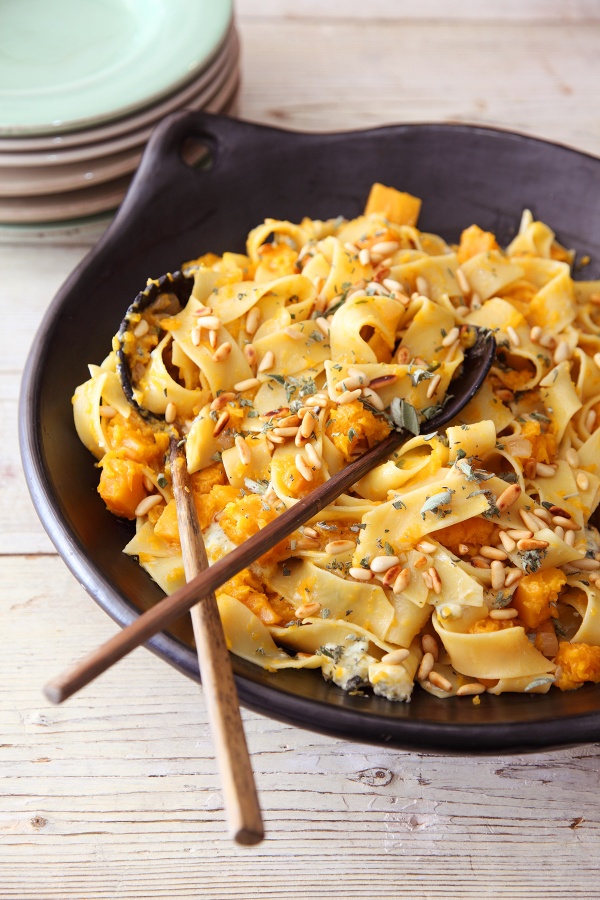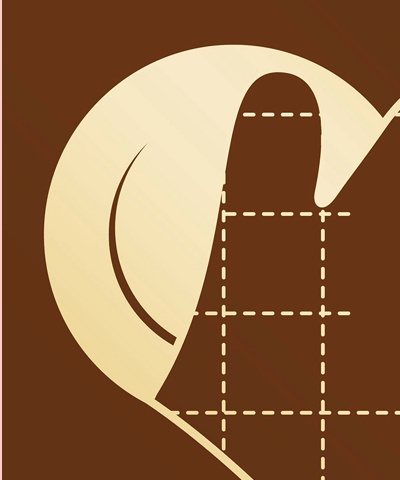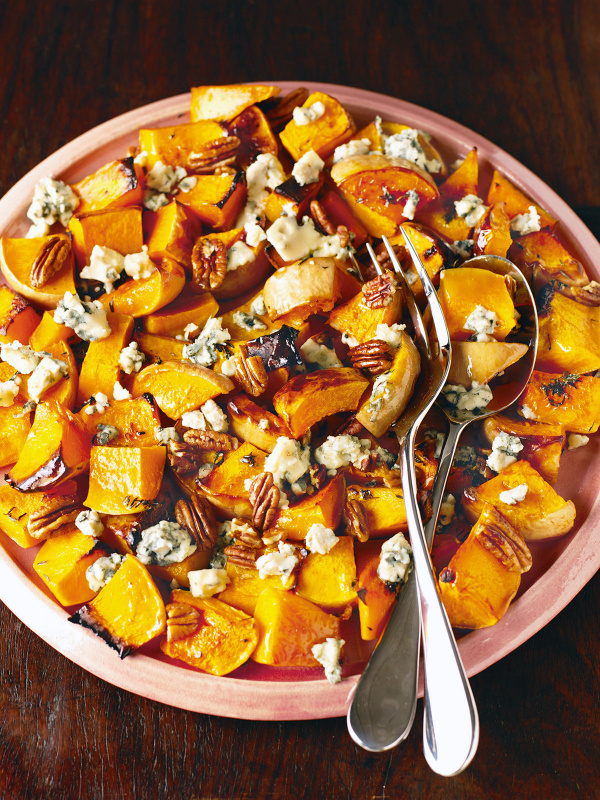Pappardelle With Butternut and Blue Cheese
by Nigella. Featured in KITCHENIntroduction
This is one of those welcoming, big-bowl suppers, perfect for feeding friends cosily. Soft, oniony cubes of squash are answered by the salty, sharp and pungent cheese; a little sage breathes its necessary but not overbearing bitterness, and the waxy, scorched pine nuts give quiet crunch, a hint of nubbliness, to this meltingly gorgeous concoction.
This is one of those welcoming, big-bowl suppers, perfect for feeding friends cosily. Soft, oniony cubes of squash are answered by the salty, sharp and pungent cheese; a little sage breathes its necessary but not overbearing bitterness, and the waxy, scorched pine nuts give quiet crunch, a hint of nubbliness, to this meltingly gorgeous concoction.

Share or save this
Ingredients
Serves: 6
- 1 large (approx. 1.25-1.5kg / 2¾-3¼lb) butternut squash or 800g / 1¾lb ready-cubed
- 1 medium - large onion
- 2 x 15ml tablespoons regular olive oil
- ¾ teaspoon smoked paprika
- 1 x 15ml tablespoon unsalted butter
- 3 x 15ml tablespoons marsala
- Maldon sea salt flakes to taste
- 100 grams pinenuts
- 500 grams pappardelle or other robust pasta
- 6 fresh sage leaves
- 125 grams blue cheese (such as Saint Agur)
- 1 large (approx. 1.25-1.5kg / 2¾-3¼lb) butternut squash or 800g / 1¾lb ready-cubed
- 1 medium - large onion
- 2 tablespoons regular olive oil
- ¾ teaspoon smoked paprika
- 1 tablespoon unsalted butter
- 3 tablespoons marsala
- kosher salt to taste
- ⅔ cup pinenuts
- 1 pound pappardelle or other robust pasta
- 6 fresh sage leaves
- 5 ounces blue cheese (such as Saint Agur)
Method
- Peel and de-seed the butternut squash, and cut into roughly 2cm (1-inch) cubes.
- Peel and finely chop the onion and fry in the olive oil in a large heavy-based pan that can accommodate the pasta later. When the onion starts to become golden, add the paprika.
- Tumble in the cubes of butternut squash and then add the butter, turning everything together in the pan. Once the squash is slicked with the oniony oil and butter, add the marsala and 125ml/½ cup of water. Let the pan come to a bubble, then put the lid on, turn down the heat and simmer for about 20 minutes or until tender.
- Meanwhile, put a large pan of water on for the pasta, adding salt only when it comes to the boil; and toast the pine nuts separately in a hot, dry pan on the hob until scorched a dark gold, then tip them into a bowl or plate to cool.
- Lift the lid off the squash pan and check the butternut is tender; if not, then cook for a little longer without the lid on — the squash should hold its shape and not turn to a mush. Once it's ready, season to taste — go easy with the salt because the blue cheese will add extra saltiness later — and take off the heat and let it wait for its happy union with the pappardelle.
- Cook the pasta according to packet instructions, though check a couple of minutes before the manufacturers declare it will be ready. While waiting for the pasta to cook — you should give the pan a loose stir or swirl every now and again — you can finely chop the sage leaves and crumble the cheese. Sprinkle most of the sage over the squash, keeping some back, and give a quick stir; but keep the cheese for now.
- Before you drain the pappardelle, lower a mug or cup into the pan and hive off a little pasta-cooking water, then tip the drained pasta into the resting sage-sprinkled squash pan and slowly turn the pasta in the sauce to combine; or you can do this in a capacious warmed bowl. If you find the sauce too dry, or if it all needs a little help coming together, add some of the pasta-cooking water — the starch in it encourages the sauce to emulsify, the better to cling to the pasta.
- Drop the crumbled cheese and about a half of the pine nuts, then — much as though you were tossing a salad — gently combine, before sprinkling the other half of the pine nuts and the reserved chopped sage on top.
- Peel and de-seed the butternut squash, and cut into roughly 2cm (1-inch) cubes.
- Peel and finely chop the onion and fry in the olive oil in a large heavy-based pan that can accommodate the pasta later. When the onion starts to become golden, add the paprika.
- Tumble in the cubes of butternut squash and then add the butter, turning everything together in the pan. Once the squash is slicked with the oniony oil and butter, add the marsala and 125ml/½ cup of water. Let the pan come to a bubble, then put the lid on, turn down the heat and simmer for about 20 minutes or until tender.
- Meanwhile, put a large pan of water on for the pasta, adding salt only when it comes to the boil; and toast the pine nuts separately in a hot, dry pan on the hob until scorched a dark gold, then tip them into a bowl or plate to cool.
- Lift the lid off the squash pan and check the butternut is tender; if not, then cook for a little longer without the lid on — the squash should hold its shape and not turn to a mush. Once it's ready, season to taste — go easy with the salt because the blue cheese will add extra saltiness later — and take off the heat and let it wait for its happy union with the pappardelle.
- Cook the pasta according to packet instructions, though check a couple of minutes before the manufacturers declare it will be ready. While waiting for the pasta to cook — you should give the pan a loose stir or swirl every now and again — you can finely chop the sage leaves and crumble the cheese. Sprinkle most of the sage over the squash, keeping some back, and give a quick stir; but keep the cheese for now.
- Before you drain the pappardelle, lower a mug or cup into the pan and hive off a little pasta-cooking water, then tip the drained pasta into the resting sage-sprinkled squash pan and slowly turn the pasta in the sauce to combine; or you can do this in a capacious warmed bowl. If you find the sauce too dry, or if it all needs a little help coming together, add some of the pasta-cooking water — the starch in it encourages the sauce to emulsify, the better to cling to the pasta.
- Drop the crumbled cheese and about a half of the pine nuts, then — much as though you were tossing a salad — gently combine, before sprinkling the other half of the pine nuts and the reserved chopped sage on top.
Additional Information
MAKE AHEAD:
Squash sauce can be cooked 1 day ahead. Simmer until the squash is just tender then transfer to non-metallic bowl to cool. Cover and refrigerate as soon as possible. Reheat gently in a saucepan before adding sage and continuing as directed in recipe.
FREEZE:
Squash sauce can be frozen, in airtight container, for up to 3 months. Defrost overnight in fridge and reheat as above.
MAKE AHEAD:
Squash sauce can be cooked 1 day ahead. Simmer until the squash is just tender then transfer to non-metallic bowl to cool. Cover and refrigerate as soon as possible. Reheat gently in a saucepan before adding sage and continuing as directed in recipe.
FREEZE:
Squash sauce can be frozen, in airtight container, for up to 3 months. Defrost overnight in fridge and reheat as above.






Tell us what you think
Thank you {% member.data['first-name'] %}.
Explore more recipesYour comment has been submitted.
What 3 Others have said
-
Posted by jtv0310 on 5th November 2023
-
Posted by Pgmooney on 6th January 2020
-
Posted by cookiedoctor on 29th December 2017
Show more commentsThis is truly one of the best pasta sauces I have ever tasted. The squash and cheese have a beautiful salt-sweet vibe that is pointed up by the Marsala, sage and the smoked paprika. Definitely a swoon worthy dish!
Tried this and wow. Great flavours and easy to make too. Could even add a little more blue cheese depending on how much you like it, but the sweetness of the butternut pumpkin and savoury notes of the blue cheese are a perfect combo. Added to my repertoire!
We really enjoyed this recipe. I didn't have enough blue cheese, so added in some goats' cheese and it was still delicious!